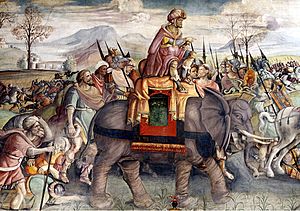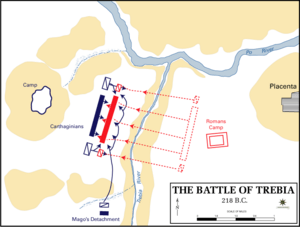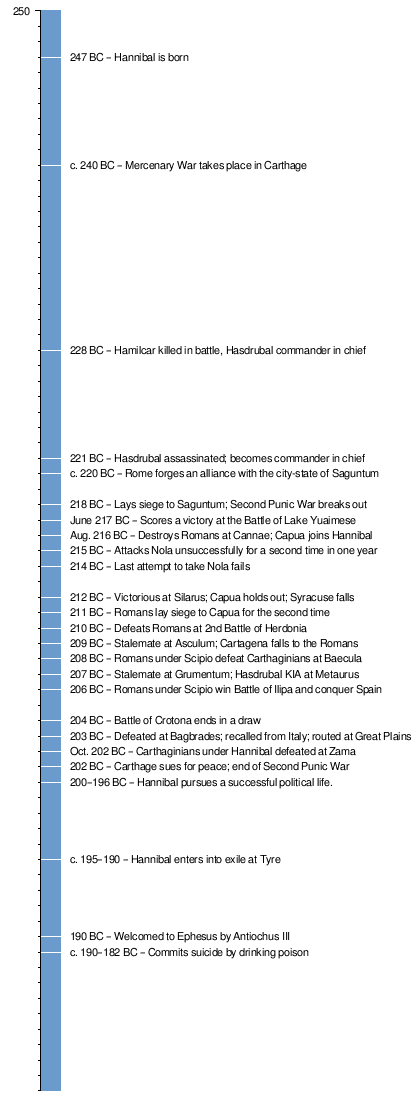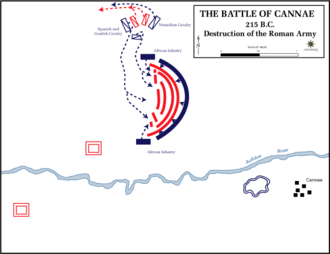Hannibal facts for kids
Quick facts for kids
Hannibal
|
|
|---|---|

A marble bust, reputedly of Hannibal, originally found at the ancient city-state of Capua in Italy.
|
|
| Born | 247 BC |
| Died | 183, 182 or 181 BC (aged 64-66) Libyssa
|
Hannibal (born 247 BC – died around 183 BC) was a famous Carthaginian statesman and general. He was a great enemy of the Roman Republic.
Hannibal is most famous for his actions in the Second Punic War. He led an army from Spain across the Pyrenees and the Alps mountains. He marched into northern Italy and won many battles against the Romans. At the Battle of Cannae, he defeated the largest army Rome had ever gathered. This Roman army had about 86,000 soldiers. More than 80% of them were killed or captured.
Hannibal kept his army in Italy for many years. Later, the Romans invaded North Africa. This made Hannibal return to Carthage to defend his home. He lost a big battle there. The Romans then made him leave Carthage. He lived in the Seleucid Empire and convinced its Emperor to fight Rome. After losing a naval battle, Hannibal escaped to another kingdom called Bithynia. When the Romans demanded he give up, he took his own life.
Hannibal is known as one of the greatest military commanders in history. A historian named Theodore Ayrault Dodge called him the "father of strategy". Even his enemies in Rome copied his military ideas.

Contents
Hannibal's Early Life
Hannibal's father, Hamilcar, was a Carthaginian commander. He fought at the end of the First Punic War. After Carthage lost that war, Hamilcar went to Spain. He wanted to conquer the tribes there. Carthage was not very strong at this time. Its navy could not carry its army to Spain. So, Hamilcar had to march his army to the Pillars of Hercules. Then they crossed the Strait of Gibraltar.
A story says that Hamilcar made Hannibal promise something important. He made Hannibal swear he would never be a friend of Rome. Hannibal told his father:
- I swear... I will use fire and steel to arrest the destiny of Rome.
Hamilcar then agreed to take Hannibal with him to Spain. Hamilcar spent two years conquering southern Spain. He died in battle around 229 BC. His son-in-law, Hasdrubal, took command. But Hasdrubal was killed in 221 BC.
After Hasdrubal's death, Hannibal became the army's leader. Rome worried about Hannibal's growing power. They made an alliance with the city of Saguntum. Saguntum was south of the Ebro River. Rome said they would protect the city. Hannibal attacked Saguntum because of this. He captured it after eight months. Rome demanded that Carthage punish Hannibal. But the Carthaginian government saw nothing wrong with his actions. So, the war Hannibal wanted began at the end of that year.
Marching to Italy
Hannibal's army had about 75,000 foot soldiers and 9,000 horsemen. He left "New Carthage" in the spring of 218 BC. He fought his way north to the Pyrenees mountains. He used clever mountain tactics to defeat the tribes there. After marching 290 miles through Spain, he reached the Ebro river. Hannibal chose his most trustworthy and loyal soldiers to continue with him. These were Libyan and Iberian mercenaries. He left 11,000 troops to guard the new lands. At the Pyrenees, he sent another 11,000 Iberian troops home. Hannibal entered Gaul (modern France) with 50,000 foot soldiers and 9,000 horsemen.
Hannibal had to cross the Pyrenees, the Alps, and many rivers. He made peace deals with the Gaulic tribal leaders. He reached the Rhône River in September. By then, his army had 38,000 infantry, 8,000 horsemen, and thirty-seven war elephants.
Hannibal avoided a Roman army sent to fight him in Gaul. He then went up a valley of the Rhône River. By Autumn, he reached the foot of the Alps. His journey over these mountains is one of the most famous military achievements ever. Hannibal came down into northern Italy, surprising the Romans. He arrived with only half the soldiers he started with. He also had only a few elephants left. Hannibal had lost about 20,000 men crossing the mountains.
Battle of Trebia

Publius Cornelius Scipio was the Roman general sent to stop Hannibal. He did not expect Hannibal to cross the Alps. Scipio thought he would fight Hannibal in Spain. With a small army in Gaul, Scipio tried to stop Hannibal. He moved his army to Italy by sea. Hannibal made the area behind him safer. He defeated the Taurini tribe (near modern Turin). The two armies met at Carthage. Hannibal forced the Romans to leave the plain of Lombardy. This victory weakened Roman control over the Gauls. Many Gauls decided to join the Carthaginians. Soon, all of northern Italy was unofficially allied with Hannibal. Gallic and Ligurian troops joined his army. His army grew back to 40,000 men. Hannibal’s army was ready to invade Italy. Scipio retreated across the Trebia River. He camped at Placentia and waited for more troops.
The Roman Senate ordered Sempronius Longus to bring his army from Sicily. Sempronius avoided Hannibal and joined Scipio near the Trebbia River. At Trebia, Hannibal defeated the Roman infantry. He used a surprise attack from an ambush on their side.
Battle of Lake Trasimene
In the spring of 217 BC, Hannibal arrived in Etruria. He wanted to trick the main Roman army into battle. This army was led by Flaminius. Hannibal found Flaminius camped at Arretium. He marched around Flaminius's left side. This cut Flaminius off from Rome. Hannibal made Flaminius chase him. On the shore of Lake Trasimenus, Hannibal destroyed Flaminius's army. Many Romans died in the lake or on the nearby hills. Flaminius was also killed. Hannibal had removed the only force that could stop him from reaching Rome.
Hannibal knew he could not take Rome without siege engines. So, he decided to continue into central and southern Italy. He hoped this show of strength would cause a revolt against the Roman government. After Lake Trasimene, Hannibal said: “I have not come to fight Italians, but on behalf of the Italians against Rome.”
Fabius's Strategy
Rome was in a state of panic. They appointed a dictator named Quintus Fabius Maximus. He was a very intelligent and careful general.
Fabius used a new plan called the "Fabian strategy". He refused to fight Hannibal in open battle. Instead, he placed several Roman armies near Hannibal. This limited Hannibal's movements. Fabius sent small forces to attack Hannibal’s groups looking for food. People in small northern villages were told to watch for Hannibal's army. They were told to gather their livestock and possessions. Then they should go to fortified towns. This plan was meant to wear down Hannibal's army.
Hannibal marched through Samnium to Campania. He hoped his destruction of the land would make Fabius fight. But Fabius still refused. His own troops became annoyed by his “cowardly spirit”. His policies were not popular. Romans were used to fighting their enemies directly. The people wanted the war to end quickly.
The rest of the autumn had many small fights. After six months, Fabius was removed from his position. This was according to Roman law.
Battle of Cannae
In the spring of 216 BC, Hannibal captured a large supply base at Cannae. This was in the Apulian plain. He placed himself between the Romans and their supplies. The Roman Senate held new Consular elections in 216 BC. They chose Caius Terentius Varro and Lucius Aemilius Paullus as Consuls. The Romans gathered their largest army ever to defeat Hannibal. It is thought that this army had about 80,000 men.
The Roman army marched south to Apulia. After two days, they found Hannibal at the Audifus River. Consul Varro was a reckless man full of pride. He was determined to defeat Hannibal. Varro's overconfidence led him into a trap. Hannibal used brilliant tactics. He surrounded and destroyed most of the Roman force.
It is estimated that 50,000 to 70,000 Romans were killed or captured at Cannae. Among the dead were eighty senators. The Roman Senate had only about 300 members. So, this was 25% to 30% of their government. The Battle of Cannae was one of the worst defeats in the history of Ancient Rome. It was also one of the bloodiest battles in human history for lives lost in a single day. After Cannae, the Romans refused to fight Hannibal in big battles. Instead, they tried to defeat him by wearing him down. They used their advantages in supplies and manpower.
Because of this victory, most of southern Italy joined Hannibal. In the same year, the Greek cities in Sicily rebelled against Roman control. The Macedonian king, Philip V, supported Hannibal. This started the First Macedonian War against Rome. Hannibal made his new base in Capua, the second largest city in Italy.
The War Slows Down
Hannibal did not get enough resources from his allies. He also did not get enough reinforcements from Carthage. So, he could not do much more. He slowly started losing ground. He continued to defeat the Romans whenever he could fight them. But he never won another big, decisive victory.
End of the War in Italy
In 212 BC, some conspirators in Tarentum let Hannibal into the city. They used Roman trumpets to sound the alarm. This allowed Hannibal's troops to attack the Romans as they came into the streets. Hannibal told the Tarentines to mark their houses. This way, their homes would not be looted. Even with the looting, the citadel (a strong fortress) held out. This stopped Hannibal from using the harbor. Rome was slowly gaining ground against Hannibal. In the same year, he lost Campania.
In 211 BC, the city of Capua fell. In the summer of that year, the Romans destroyed the Carthaginian army in Sicily. Meanwhile, Hannibal had defeated Fulvius at Herdonea in Apulia. But he lost Tarentum. With the loss of Tarentum in 209 BC, his control over southern Italy was almost gone. The Romans also captured Samnium and Lucania.
In 207 BC, he moved back to Bruttium. These events marked the end of Hannibal's success in Italy. In 203 BC, Hannibal was called back to Carthage. He was needed to lead the defense of his homeland against a Roman invasion.
End of the Second Punic War (203–201 BC)
The Battle of Zama
Scipio and Hannibal met on the battlefield of Zama. Hannibal had about 50,000 foot soldiers and 4,000 horsemen. Scipio had 34,000 foot soldiers and 8,700 horsemen. For years, Hannibal had won battles with his experienced army. Now, he faced the best of the Roman army. He led an army that was quickly put together. His army did not do well against the Romans.
Hannibal was defeated. About 20,000 of Hannibal’s men were killed at Zama. The same number were taken as prisoners. The Romans lost only about 500 dead and 4,000 wounded. With their best general defeated, the Carthaginians accepted defeat. They surrendered to Rome.
Exile and Death (195–183 BC)
Seven years after the victory at Zama, the Romans demanded Hannibal's surrender. Hannibal chose to go into voluntary exile. He traveled to Tyre, the mother-city of Carthage. Then he went to Ephesus and Syria.
In 190 BC, he was put in charge of a Phoenician fleet. But he was defeated in a battle off the Eurymedon River. Hannibal went to Crete. But he soon returned to Asia Minor. At Libyssa, on the eastern shore of the Sea of Marmara, he was about to be handed over to the Romans. Instead of letting himself be captured, he drank poison. The exact year of his death is not certain. It is believed to be 183 BC. He died in the same year as Scipio Africanus.
Timeline
| Timeline of Hannibal's life (248 BC – c. 183 BC) |
|---|
 |
Battle Record
| Allegiance | War | Year | Action |
|---|---|---|---|
| Carthaginian Empire | Barcid conquest of Hispania | 221 BC | Siege of Alithia |
| 220 BC | Siege of Helmantice | ||
| Siege of Arbucala | |||
| Battle of the Tagus | |||
| 219 BC | Siege of Saguntum | ||
| Second Punic War | |||
| 218 BC | Battle of Rhone Crossing | ||
| Battle of Ticinus | |||
| Battle of the Trebia | |||
| 217 BC | Battle of Victumulae | ||
| Battle of Lake Trasimene | |||
| Battle of Ager Falernus | |||
| Battle of Geronium | |||
| 216 BC | Battle of Cannae | ||
| Battle of Nola | |||
| Siege of Casilinum | |||
| 215 BC | Battle of Nola | ||
| 214 BC | Battle of Nola | ||
| 212 BC | Battle of Tarentum | ||
| Battle of Capua | |||
| Battle of the Silarus | |||
| Battle of Herdonia | |||
| 211 BC | Siege of Capua | ||
| Raid on Rome | |||
| 210 BC | Battle of Herdonia | ||
| Battle of Numistro | |||
| 209 BC | Battle of Canusium | ||
| Battle of Caulonia | |||
| 208 BC | Battle of Petelia | ||
| 207 BC | Battle of Grumentum | ||
| 204 BC | Battle of Crotona | ||
| 202 BC | Battle of Zama | ||
| Seleucid Empire | Roman–Seleucid War | 190 BC | Battle of the Eurymedon |
| Bithynia | Pergamese-Bithynian War | 184 BC | Battle of the Sea of Marmara |
Images for kids
-
A quarter shekel of Carthage, possibly made in Spain. The front might show Hannibal as a young Melqart. The back shows one of his famous war elephants.
-
Hannibal and his men crossing the Alps.
-
Bust of Scipio Africanus from the Villa of the Papyri.
-
The final part of the Second Punic War with the battle of Zama (202 BC).
-
An engraving of the Battle of Zama by Cornelis Cort, 1567. Notice that Asian elephants are shown, not the smaller North African elephants used by Carthage.
-
A legendary scene: in Snow Storm: Hannibal and his Army Crossing the Alps, J.M.W. Turner shows Hannibal's crossing of the Alps with a Romantic feeling.
-
A bust of Hannibal, from the 17th century, at the Museum of Antiquities (Saskatoon).
-
Hannibal's monumental tomb in Kocaeli, Turkey.
See also
 In Spanish: Aníbal para niños
In Spanish: Aníbal para niños















